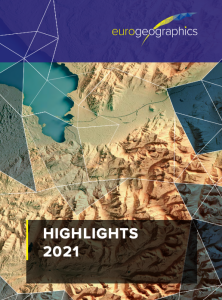Authoritative data – the backbone of global climate and pollution action
 As a geographer, I firmly believe that there are few things that are more powerful than location; it not only tells us where things happen but also provides the link between information and action. This is very true when it comes to the impact geospatial data can have in fighting climate change and pollution.
As a geographer, I firmly believe that there are few things that are more powerful than location; it not only tells us where things happen but also provides the link between information and action. This is very true when it comes to the impact geospatial data can have in fighting climate change and pollution.
Indeed, as the world counts down to the United Nation’s 2030 Agenda, trusted data is more important than ever for monitoring, managing and measuring progress towards the Sustainable Development Goals (SDGs). Data from Europe’s National Mapping, Cadastral and Land Registration Authorities is already being used to realise national climate targets and biodiversity plans, and deliver smarter, sustainable, intelligent transport.
Geospatial data is at the core of all environmental actions ‘on the ground’ – when talking about farming, for example, it is key in defining exactly how much water would be needed for irrigation. It is also making transport more efficient, such as with the Belgian National Access Point for multimodal transport information, and is supporting the transition to solar energy in the Netherlands, and many other countries, through ‘solar-cadastre’.
Nonetheless, whilst I do find the ‘operational aspects’ of using geospatial data fascinating, I must admit that I have some soft spots for its wider use in supporting policies. In Portugal, land cover maps are revealing new insights about the landscape, whilst in France new land use and Lidar projects are supporting public policies, such as spatial planning, agriculture, forest, energy, biodiversity, and climate. This analytical aspect shows just how powerful geodata is for the public good.
However, all too often borders prove to be obstacles in translating national benefits into international policy success. In my opinion, geospatial data is the only smart way to work beyond the notion of border and be efficient.
In this day and age, challenges do extend beyond national boundaries, and knowing exactly where to target action and coordinate responses is essential.
For example, Pascal Canfin, Chair of the European Parliament Committee on the Environment, Public Health and Food Safety recently noted that pollution does not respect borders. To track and tackle it across Europe, we need to be able to monitor its spread across different countries – and to do this we need pan-European data we can trust.
Together with our members, we provide the only interoperable pan-European datasets created using official authoritative geospatial data. All are updated annually and harmonised to standard specifications, so users can be confident that the information provided is consistent, comparable and easily shared — regardless of its national source. Members’ foresight in creating datasets covering geographical Europe has already delivered huge value for users requiring cross-border information, and they continue to support both national and international policy through their strategic vision of a society empowered by the use of their trusted geospatial services. I know that they will again deliver should further datasets prove necessary to answer tomorrow’s challenges.
From knowing who owns the soil and its responsible management, to air quality and the reduction of pesticides, our members’ data is available as a tool to mitigate pollution and address the challenge of biodiversity loss. If we are to achieve a healthy planet, we believe authoritative geospatial information should be a vital component of the EU Zero Pollution Action Plan.
Zero pollution is just one of the EU environmental policies that benefits from members’ data. With the European Parliament calling for the EU Environment Action Programme to be aligned with the European Green Deal on climate and biodiversity, their official information also has a clear role in helping the EU to become a climate-neutral, resource-efficient, clean and circular economy. MEPs have also said that Member States should integrate the SDGs, as well as climate, environmental and social objectives, in their national plans.
The 2030 Agenda and SDGs depend on geospatial information which enables the connection between people, their location and place, and to measure where progress is, or is not, being made. Cadastral information, registries and mapping databases are therefore critical to enabling countries to report and monitor progress on achieving the SDGs.
More than ever before, the world needs accurate data that it can trust is up to date, definitive and detailed. We know we cannot expect users to always come to us, so we continue to find new ways of achieving its widespread use across both the European and international systems.
Members recognise that the value of their information lies in its use and reuse. Many have already made their data open and accessible, a trend that will continue.
The Open Maps for Europe project extends these benefits to pan-European datasets created using official map, geospatial and land information. These include topographic data and a digital elevation model to be released at the end of summer 2021, and imagery, a cadastral index map, and a regional gazetteer which will be available by the end of 2022. In terms of fighting pollution for example, these datasets can be used for visualising its impact but also enable analysis of data to help anticipate and mitigate its spread.
We are coordinating the project, which is co-financed by the Connecting Europe Facility of the European Union, in partnership with the National Geographic Institute (NGI) Belgium.
The global pandemic has redefined business as usual – from accelerating the adoption of new technologies to refocusing resources. As a community used to constant and far-reaching change, we have a proven ability to respond strategically, as well as operationally, to these new ways of working. Together, we must ensure this agility, as well as our data, is widely recognised, understood and used for maximum impact and benefit.
That’s why we are highlighting the key role of pan-European data in tackling cross-border pollution and call for authoritative geospatial information to be included in EU Zero Pollution Action Plan.
Find out more by reading our case studies demonstrating the important role of EuroGeographics members.

 Our last
Our last  In 2021, we continued to support the public good by representing our members’ interests by facilitating access to, and use of, their official geospatial data and services, and maintaining networks to help them improve their capabilities and role.
In 2021, we continued to support the public good by representing our members’ interests by facilitating access to, and use of, their official geospatial data and services, and maintaining networks to help them improve their capabilities and role. As a geographer, I firmly believe that there are few things that are more powerful than location; it not only tells us where things happen but also provides the link between information and action. This is very true when it comes to the impact geospatial data can have in fighting climate change and pollution.
As a geographer, I firmly believe that there are few things that are more powerful than location; it not only tells us where things happen but also provides the link between information and action. This is very true when it comes to the impact geospatial data can have in fighting climate change and pollution.